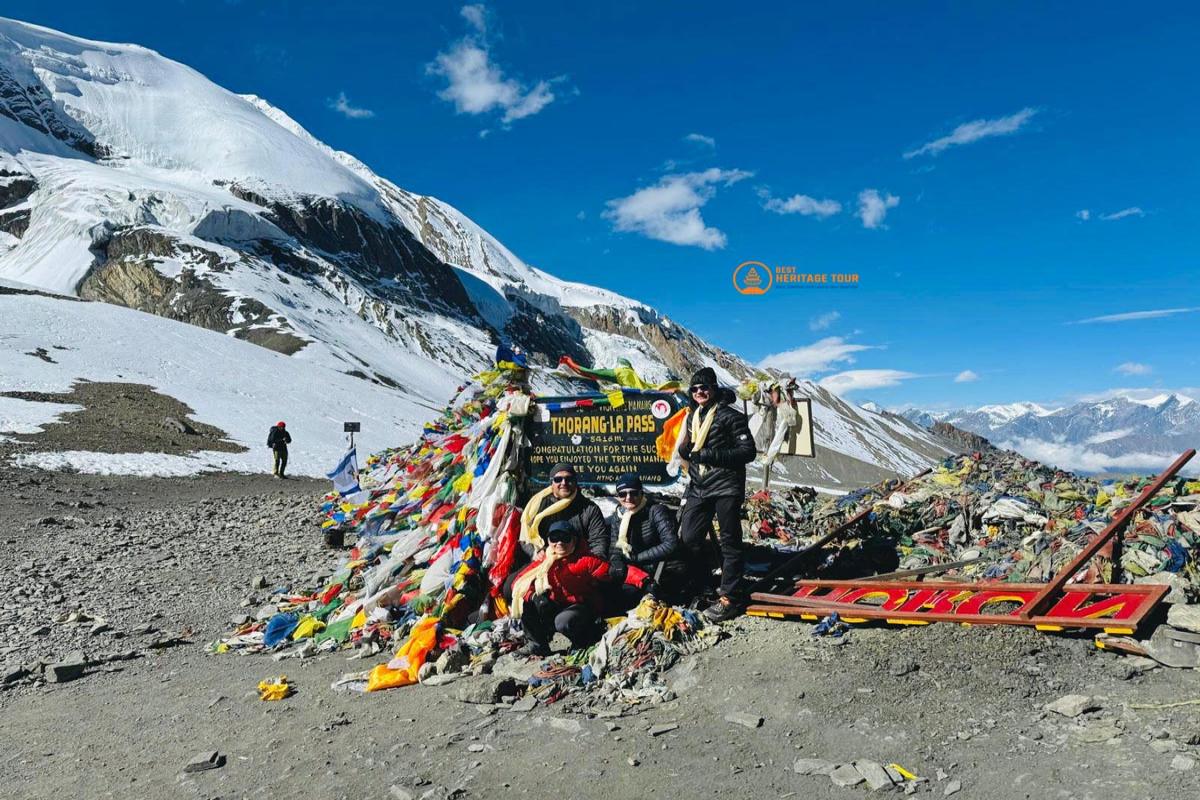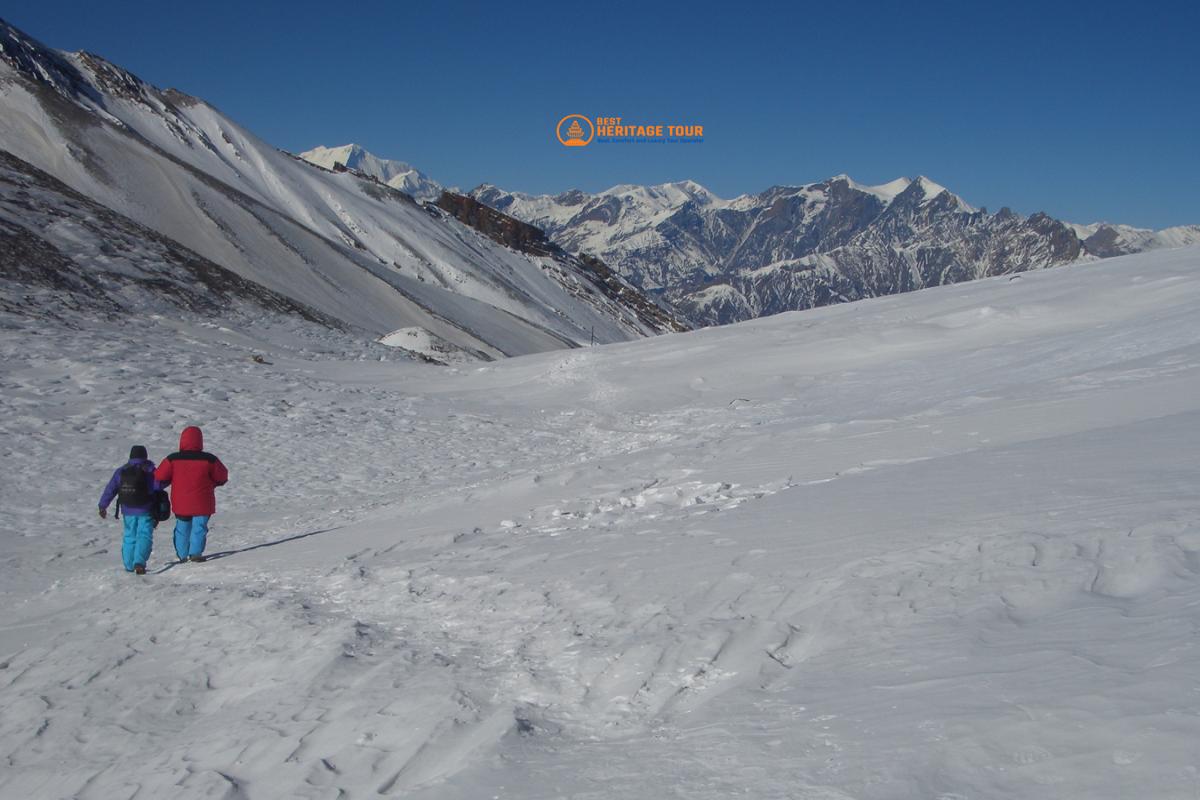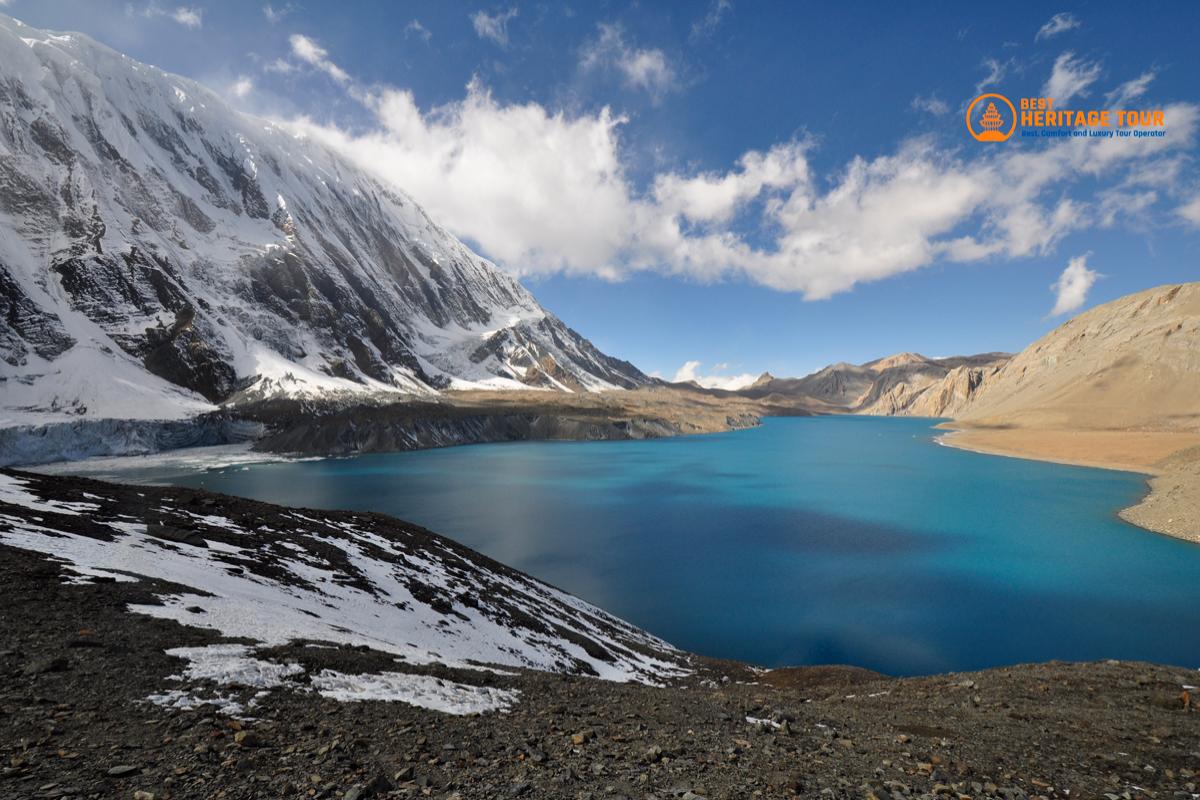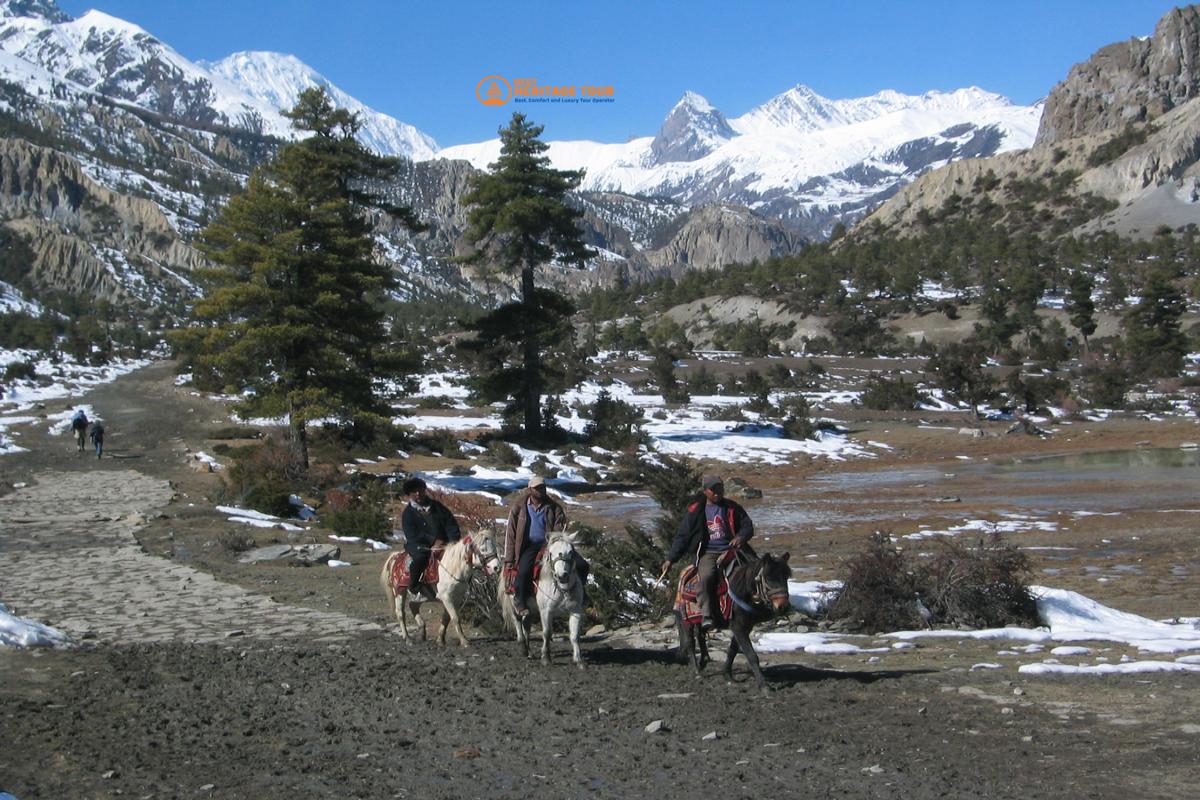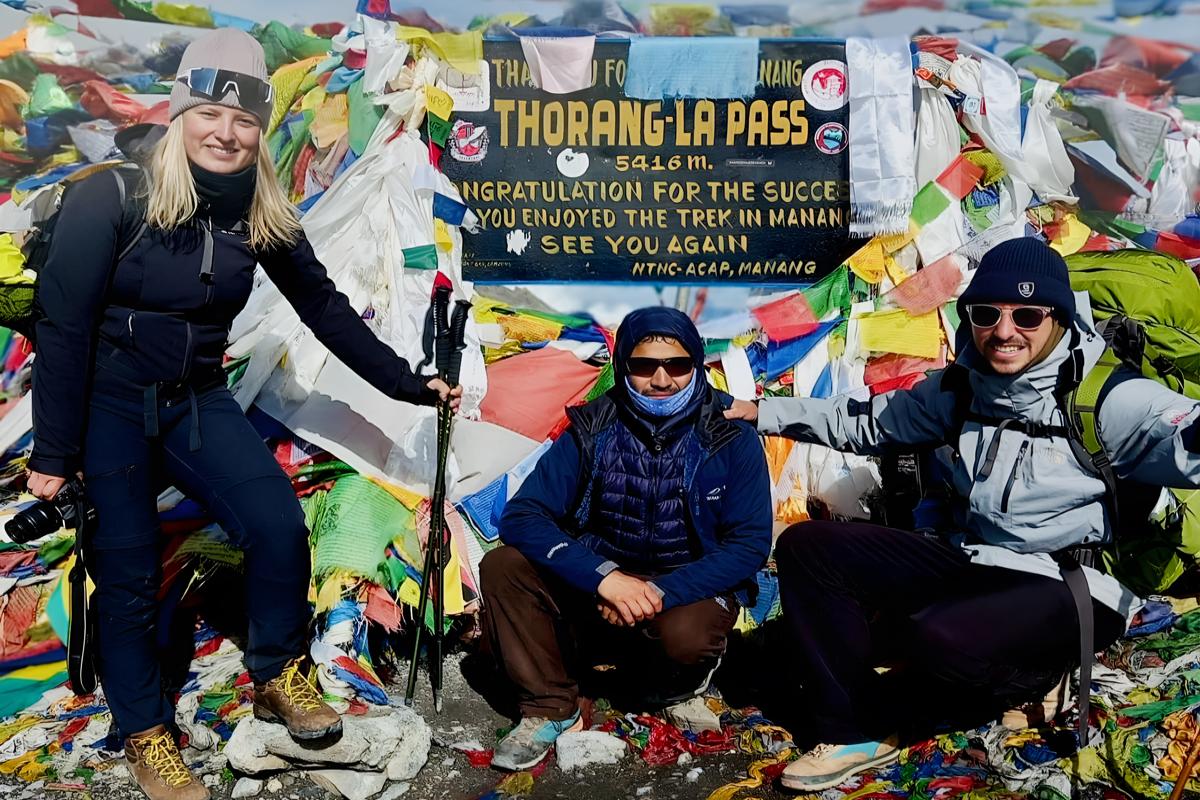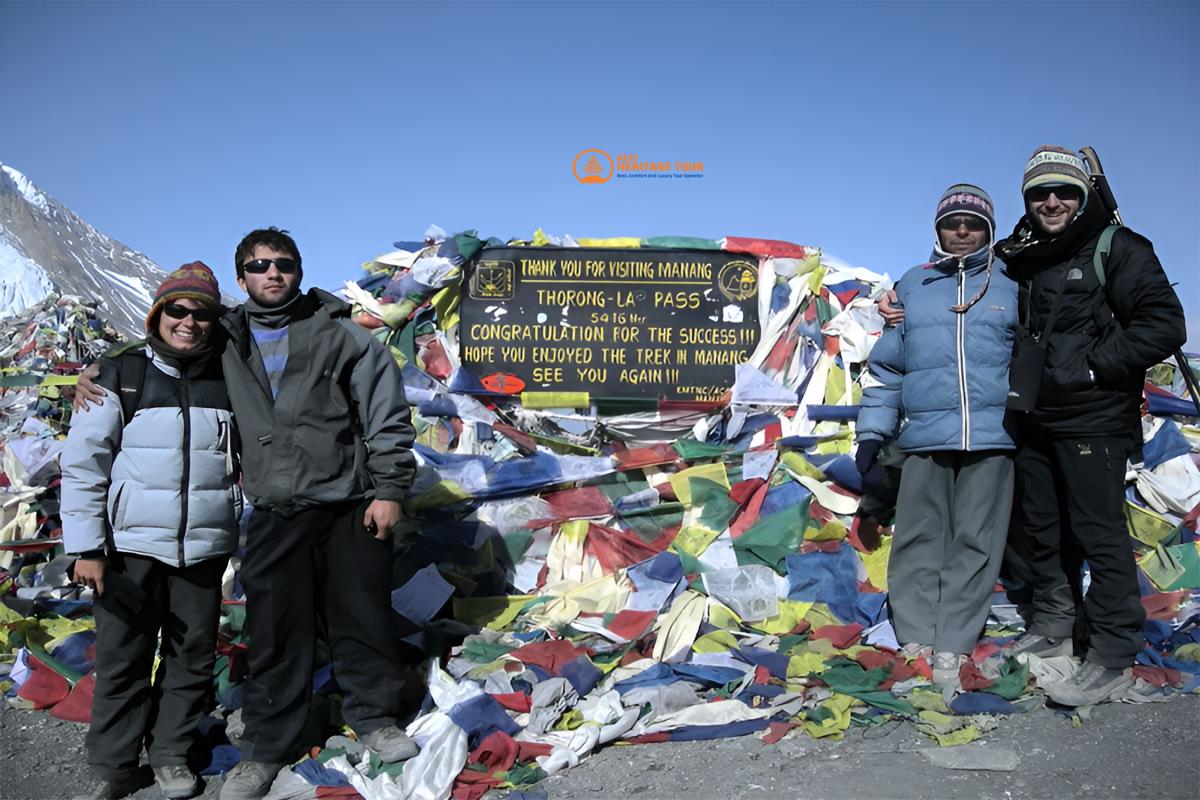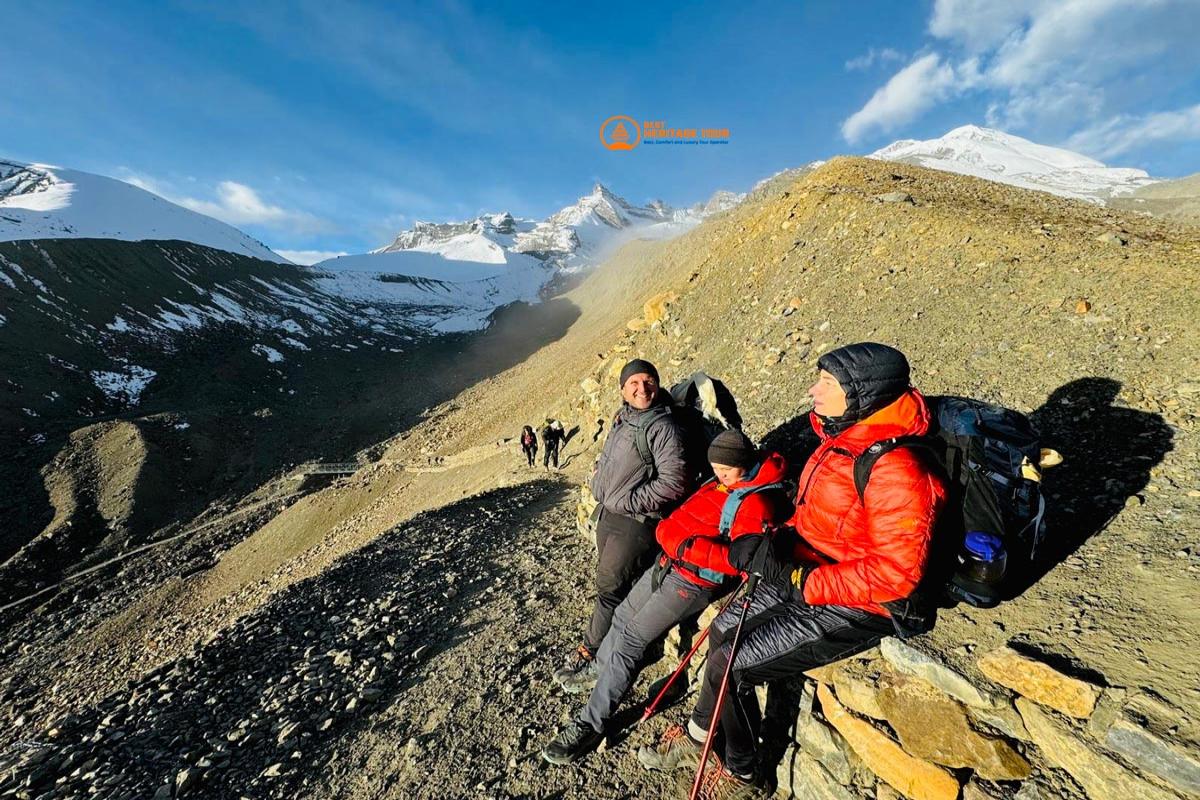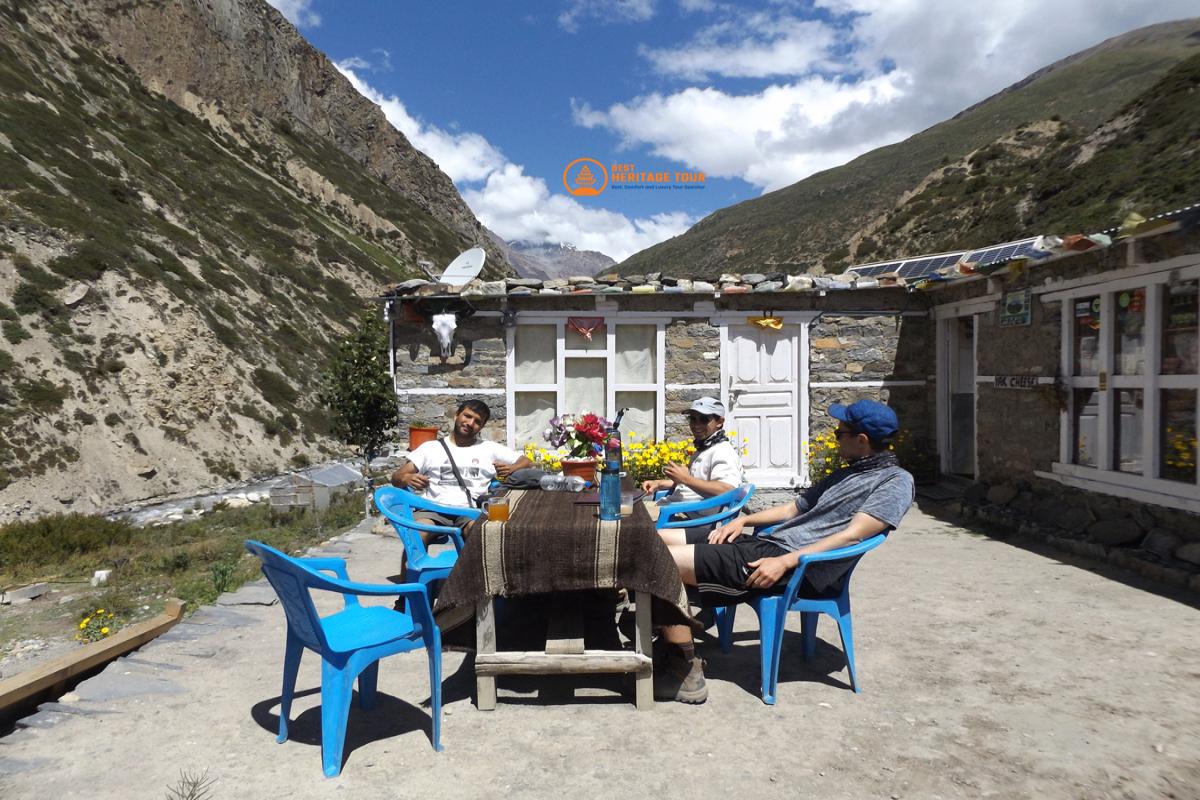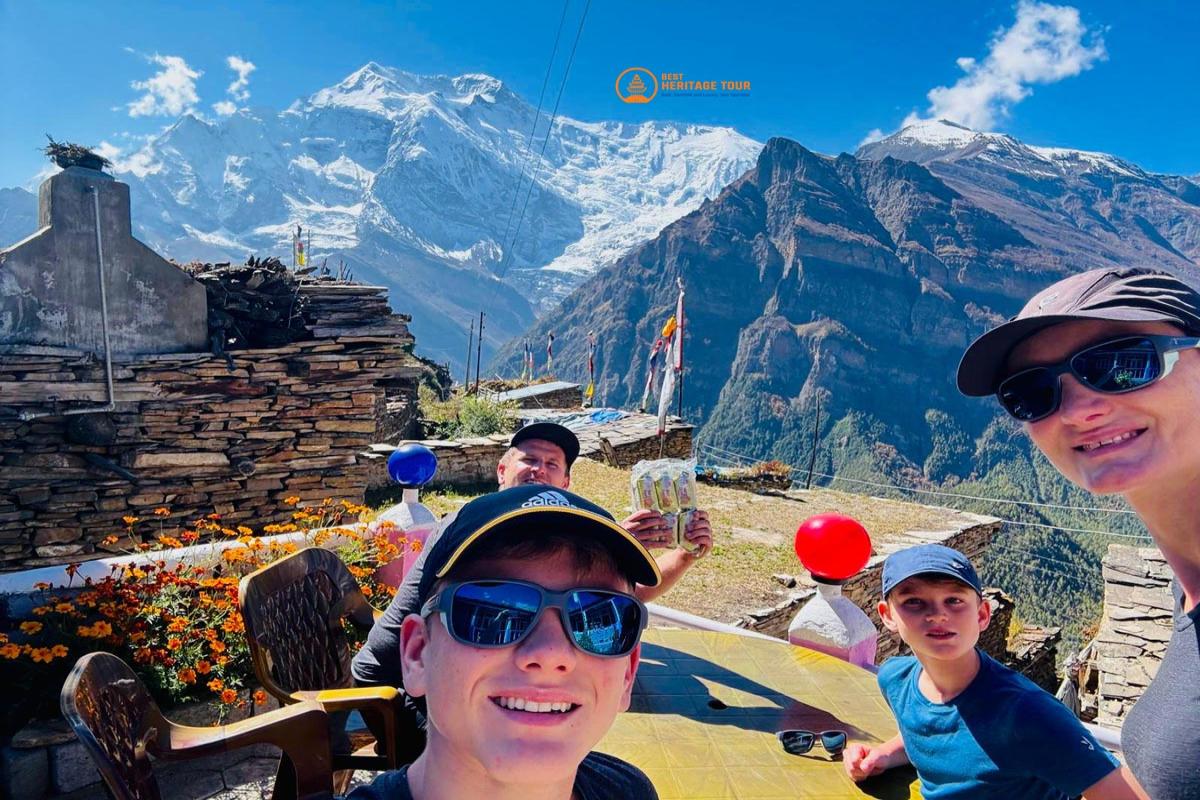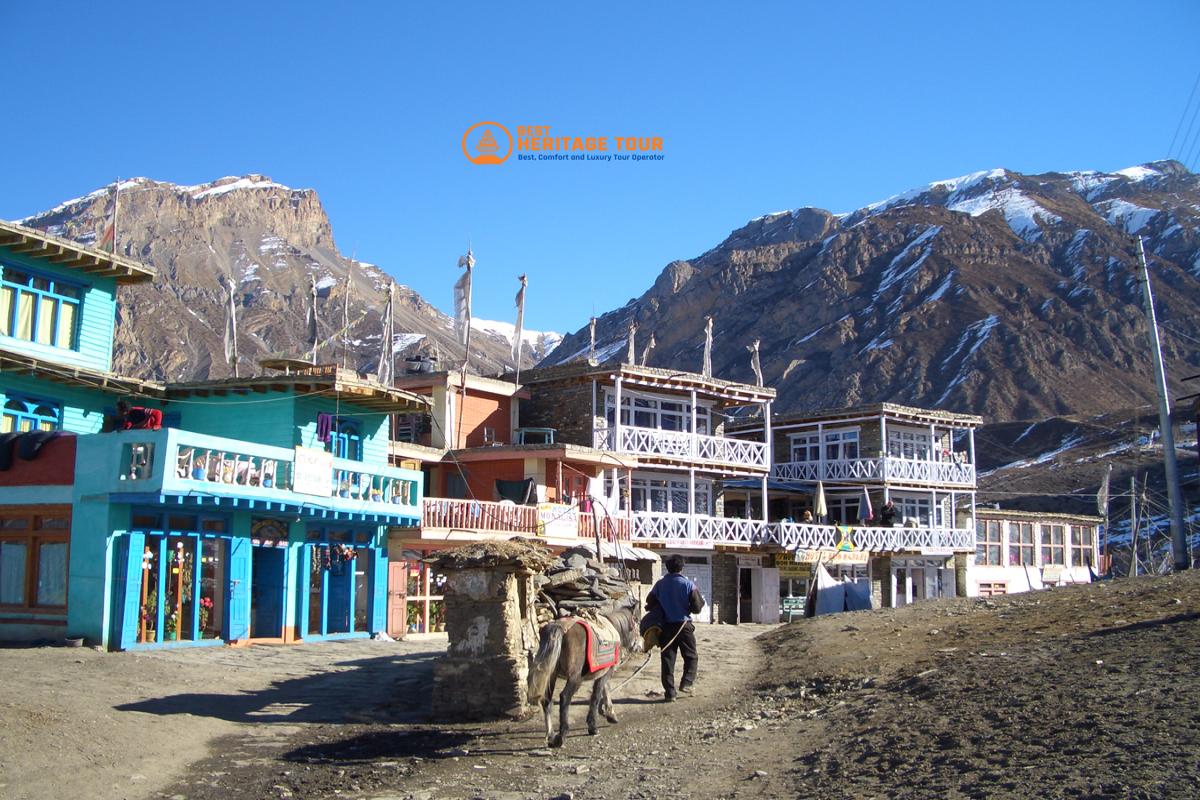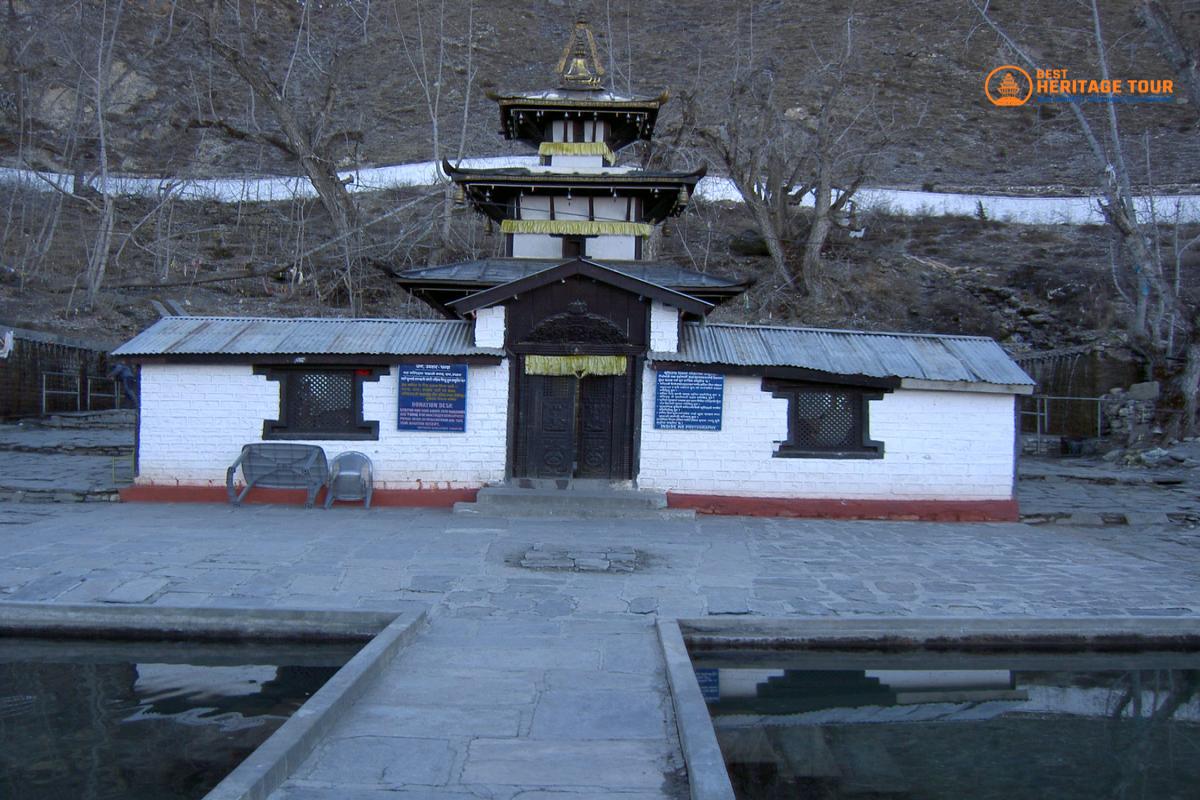Annapurna Circuit Short Trek with Tilicho Lake - 9 Days
Insight on Annapurna Circuit Trek with Tilicho Lake
The 9-day Annapurna Circuit Trek with Tilicho Lake provides an unforgettable combination of adventure and cultural exploration. Trekkers experience diverse landscapes, from lush forests to barren highlands, with panoramic views of the Annapurna range. Reaching Tilicho Lake (4,920m) provides a surreal, high-altitude experience, while crossing Thorong La Pass (5,416m) presents a thrilling challenge with views of towering peaks like Dhaulagiri and Manaslu. Throughout the journey, trekkers engage with local communities, experiencing the depth of the region's rich Buddhist culture. The trek concludes with scenic drives, offering a perfect balance of natural beauty and cultural exploration.
Trip at a Glance
Key Highlights
- Annapurna Circuit Trek with Tilicho Lake
- Sunrise views of the Annapurna range, including Dhaulagiri, Annapurna I, and Nilgiri
- Tilicho Lake (4,920m), one of the highest lakes in the Nepal as well as in World
- Varied landscapes, ranging from lush forests to barren highlands
- Rich Buddhist culture with local communities like the Tamang, Gurung, and Thakuri
- Steep trails, high mountain passes, and suspension bridges
- Thorong La Pass at 5,416 meters
- Enjoyable drive to Pokhara and Kathmandu after finishing the trek
Benefits of Annapurna Circuit Trek with Tilicho Lake with Best Heritage Tours
- Free transfers between airports with private transport on arrival and departure
- Online travel consultation after booking confirmation
- Pulse oximeter monitors blood oxygen saturation at high altitudes to detect early signs of impending altitude sickness and other potential health risks.
- Easy booking and reservation system
- Communication Channel (email, WhatsApp, WeChat, , Skype, Zoom Viber Facebook,) Telephone contact 24/7.
- Easy payment system.
- Free storage service for excess luggage during the hike
- If you don't have your own sleeping bag or down jacket, we will provide you.
Trip Overview
The 9 Days Annapurna Circuit Trek with Tilicho Lake stands out as one of the most remarkable and challenging hiking experiences in Nepal, attracting adventurers and nature enthusiasts from around the globe. This trek is not only a physical challenge but also a journey through some of the most breathtaking landscapes on Earth, characterized by majestic mountains, lush forests, and vibrant cultural experiences. It is particularly ideal for those with limited time in Nepal, as it conveniently begins in the bustling capital city of Kathmandu and concludes in the picturesque lakeside town of Pokhara.
As trekkers embark on this adventure, they will traverse rugged terrains and arid landscapes, particularly in the Manang Village area. The trek offers an opportunity to explore breathtaking highlands, including the world-renowned Tilicho Lake, which is celebrated as one of the highest lakes in the world. Along the way, hikers will be treated to stunning views of the Annapurna mountain range, with its towering peaks and dramatic valleys that seem to stretch endlessly into the horizon. The trek also provides a unique chance to visit notable cultural and religious sites, allowing travelers to immerse themselves in the rich heritage of the Annapurna region.
One of the major attractions of this trek is the chance to visit Tilicho Lake, which is located at an altitude of 4,920 meters. Those who make it to this stunning destination will be captivated by the lake's clear turquoise waters, which reflect the surrounding mountains and sky, creating a mesmerizing sight that is truly unforgettable. The experience of standing at the edge of this high-altitude lake, surrounded by the grandeur of the Himalayas, is a moment that many trekkers cherish for a lifetime.
The Annapurna Circuit Trek is well-regarded not only for its stunning scenery but also for its rich Buddhist culture, traditions, and practices. The villages along the route are home to diverse communities, primarily consisting of the Tamang, Gurung, and Thakuri people. Trekkers will have the chance to engage with local residents, discover their way of life, and experience the warmth of their hospitality. The cultural richness of the region adds an enriching layer to the trekking experience, making it not just a physical journey but also a cultural exploration.
While the Annapurna Circuit Trek is considered to be more challenging than many other treks in the region due to its rapid pace and varying altitudes, it is designed to accommodate hikers of all levels. The trek features longer, easier trails that allow most travelers to undertake the journey with a moderate level of fitness This easy accessibility makes it a popular choice for both seasoned.
You will hike up several steep trails with rocks and boulders. The route takes you through high mountain passes, crossing multiple suspension bridges and climbing steep slopes. During the trek, you will visit Tilicho Lake (4,920m), explore its stunning surroundings, and then continue on towards the Round.
The trek becomes more challenging from Siri Kharka onward, as it steadily ascends to the highest point of the journey. The hike is mostly steep, gaining significant elevation and ending at the top of Thorong La Pass (5,416 meters).
Once you reach Thorong La Pass, you will enjoy stunning views of the Annapurna massif, Gangapurna, Manaslu, Nilgiri, and Dhaulagiri. You will also see glacial moraines, Rocky Mountains, and colorful valleys. After taking in the beautiful scenery, you will descend to Muktinath. From Muktinath, you will drive for 8-9 hours to Pokhara. The following day, you will take a 7-hour drive to Kathmandu.
Itinerary
Today, we will take a bus ride to Besisahar, which will take about 6-7 hours, followed by a jeep ride to Jagat and then on to the lively town of Dharapani (1860m). Our adventure continues as we make our way to Chame, located alongside the beautiful Marsyangdi River. Throughout the journey, you'll be treated to spectacular views of Annapurna II (7,937m), Lamjung Himal (6,932m), Manaslu (8,154m), and Peak 29 (7,833m).
Once we depart from Chame, our journey takes us to the village of Telekhu. Along the trail, we are treated to stunning views of the Annapurna Ranges and Mt. Pisang, which stands at 6091 meters. As we continue on our journey, we will need to cross a suspension bridge again to reach the southern side of the Marsyangdi River. From there, we will ascend through a beautiful pine forest and venture into the higher areas of the Manang Valley, eventually arriving at Pisang.
Pisang marks the start of our journey into the upper Manang region. Today, we’ll be trekking along a path that leads us to Braga, a Tibetan village known for its distinctive architecture, featuring houses stacked on top of one another. One of the highlights of Manang is its Gompa, the largest Buddhist temple in the area. This region is a favorite among trekkers who often pause here to acclimatize before continuing their ascent.
As we depart from Manang, we come across the distinctive village of Khangsar, known for its unique stone houses and rich culture. The path winds along the ridge until we arrive at Khangsar, which sits at an elevation of 3734 meters. From this village, you can enjoy a rare glimpse of the lesser-known Kang Guru Peak, towering at 6981 meters.
Today, we embark on an exciting trek towards Tilicho Lake, which will take us about 5 to 6 hours. This stunning lake sits at the foot of Tilicho Peak, towering at 7134 meters. As we make our way along the path, keep an eye out for yaks and deer peacefully grazing. The lake's colors shift beautifully in the changing light, showcasing various shades of blue. After spending some time soaking in the breathtaking views and capturing photos of the lake and surrounding mountains, we will head back to Sri Kharka. The lake covers an area of 4.8 square kilometers.
Today, we kick off our journey as we make our way down to Khangsar Village, stopping by Tare Gumba (3870m), famous for its beautiful monastery. We’ll follow the Thorong Khola Valley to the deserted village of Old Khangsar, and then proceed to Yak Kharka. After a three-hour hike, we'll arrive at Thorong Phedi, where we'll stay in a guesthouse.
Today is likely the most challenging day of our trek, as we’ll be hiking for about 7 to 8 hours. The higher altitude adds to the difficulty, and we might encounter strong winds in these elevated areas. Along the way, we could see sheep, yaks, and merchants carrying their goods. Upon reaching Thorong La Pass, we'll be greeted by breathtaking views of Annapurna, Gangapurna, and the impressive peak of Khatungkang (6,484 m). After leaving the pass, we’ll descend approximately 1600 meters, where we’ll catch sight of Dhaulagiri (Dhavali giri, which means “White Mountain”), and the tallest mountain entirely within Nepal. The trail becomes more rolling and relatively easier as we make our way to Muktinath, where we’ll spend the night after a long 10-hour trek.
From Muktinath, our journey takes us to the towns of Jomsom, Tatopani, and Beni Bazaar as we make our way to Pokhara. Pokhara is famous for its beautiful Phewa Tal (lake), where we will spend the night at a hotel. Feel free to explore the shops along the lakeside and enjoy a peaceful moment by the water as you watch the sunset over the stunning Annapurna ranges.
Today is the last day of our tour. We are driving back to Kathmandu where we start our tour. While returning to Kathmandu, we will cross the Marsyangdi river and and then the Trisuli River and drive along the bank of Trisuli river to reach the city.
What is included?
- Travel from Kathmandu to Besisahar by bus, and then take a shared jeep to Chame, and finally a local bus from Jomsom to Pokhara.
- Journey to Kathmandu from Pokhara using a tourist bus.
- Enjoy one night stay at a chosen hotel in Pokhara, including breakfast.
- Stay in tea houses or lodges during the trek, with meals provided: breakfast, lunch, and dinner.
- Experienced and qualified trek leader (guide) with a government license, plus an assistant guide for groups of eight or more.
- Use of sleeping bag, down jacket, duffel bag, and walking poles provided (to be returned after the trip if not owned).
- Sherpa (assistant guide) if group size is more than 10 people. Besides that, food, accommodation, salary, insurance, equipment.
- Experienced English speaking guides are nationally qualified and provide food, accommodation, salary, insurance and equipment.
- Permits for ACAP (Annapurna Conservation Area Project) and TIMS (Trekker Information System) maps.
- Use an oxygen meter to monitor your pulse, oxygen levels, and heart rate twice a day, helping to identify symptoms of Altitude Mountain Sickness (AMS) for your safety during the trek.
- An assistant guide is provided for groups of eight or more.
What is not included?
- Meals provided during your stay in Kathmandu and Pokhara, including lunch and dinner.
- Visa fee for entering Nepal (available on arrival at Tribhuvan International Airport in Kathmandu): $30 for 15 days, $50 for 30 days, and $125 for 90 days.
- Personal travel and health insurance are required.
- Accommodation in hotels while in Kathmandu.
- International flight tickets, airport departure tax, visa fees.
- Personal expenses are your responsibility.
- All drinks and snacks purchased during the trek, including alcoholic and non-alcoholic beverages, soup, tea, coffee, hot chocolate, and mineral water.
- Desserts and sweet treats like chocolate, cake, pie, and pudding are not included.
- Hot showers and battery charging services at tea houses are extra.
- Gratuities for your guide, porter, and driver are expected.
- Note: If you come back early from the trek because of illness or any issue, the money you spent on flights, hotels, mountain rooms, food, and so on cannot be refunded. You will be responsible for covering your own expenses for hotel, food, and other costs in Kathmandu.
- All government taxes 13%, SSF, and 10% service charges
Route Map
Equipment
Upper Body- Head / Ears / Eyewear
- A pair of half gloves
- A warmer hat that covers the ears
- Sunglasses
- Neck warmer
- Sunscreen (35 to 60 SPF)
- Flashlight and a spare set of batteries
Hands
- Half gloves for better grip on your trekking pole(if you want)
- Warmer shell gloves and liner
Upper Body
- long sleeve t-shirts
- Thermal tops
- wool jacket or pullover
- Sports bras for women and girls
- Water and windproof shell jacket
Lower Body
- Thermal underwear (especially trousers)
- windproof and waterproof trousers
- warmer trousers
- Comfortable trekking pants
- Extra casual sport pants
Footwear
- Trekking Boots(Waterproof )
- Pair of sandals
- 4-5 pairs of woolen socks
- Sock liners
- Light shoes and sneakers
First Aid Kits and Medicines
- Assorted adhesive bandages (fabric preferred)
- Blister treatment cream or similar
- Insect / anti-itch ointment
- Ibuprofen or other pain-relief medication
- Diamox (for altitude sickness)
- Water purifying tablets
Trip Info
Best Time for a 9-Day Short Annapurna Circuit Trek with Tilicho Lake
The best time to embark on a 9-day Annapurna Circuit trek is typically during the spring (March to May) and autumn (September to November) seasons. These periods offer dry trekking conditions and stunning views of the Annapurna region, with consistent weather that enhances the overall trekking experience.
Spring Season
Spring breathes life into the entire Himalayan region, with vibrant wildflowers decorating the lower trekking paths. It’s a fantastic time to experience the diverse flora and fauna of the Annapurna Conservation Area.
The colorful landscapes, lush hills, clear blue skies, and snow-capped peaks provide the perfect backdrop for memorable photos. Temperatures in the Annapurna region during spring range from 14°C to 23°C during the day, with cooler evenings dropping to around 5°C.
As you trek above 4,000 meters, expect alpine conditions, with freezing temperatures in the mornings and evenings. Be prepared for varying weather, including sudden temperature drops and potential snow.
Autumn Season
Autumn is considered one of the best seasons for trekking in the Himalayas. The weather is mild and stable, with daytime temperatures ranging from 10°C to 20°C—perfect for trekking as it’s neither too hot nor too cold.
Clear skies during autumn offer the best views of the majestic Himalayan peaks, while the lush, monsoon-fed landscapes make each day’s hike more enchanting. Like spring, autumn is also a paradise for nature lovers, with crisp air and vibrant foliage adding to the trek's beauty.
Review
Best views of mountains and lake
Annapurna circuit short trek with Tilicho Lake was one of the best way to explore the Annapurna region and Tilicho Lake in short period of time. This was one of the best trek that...
View DetailBest days of my life in mountains
Amazing tour of my life. I got to explore famous places in the Himalayas such as tilicho base camp, throng la pass and muktinath temple. I explored many types culture and tradition...
View Detailgreat trek and beautiful mountain lake
Those 9 days I had spent in the Annapurna circuit trek with tilicho lake was the best time of my life. I got to explore the beautiful mountains and local native people of the...
View DetailFAQ's
While Nepali is the primary language, most staff members in lodges speak English, and some may even speak other languages. Communication should not be an issue for international tourists.
It’s advisable to be up-to-date on routine vaccinations, including hepatitis A and typhoid. Talk to your doctor about the vaccinations you need for Nepal.
The majority of international flights arrive at Tribhuvan International Airport, which is located in Kathmandu. From this location, travelers can connect to Lukla to commence their trekking journey.
You typically need a valid passport, a completed visa application form, and a passport-sized photo. Payment can be made in cash or via card at the airport.
Yes, tourist visas are eligible for extension at the Department of Immigration located in Kathmandu. Ensure you have a valid reason and required documents for the extension.
If you wish to extend your stay in Nepal beyond your visa’s initial duration, you can do so by applying at the Department of Immigration in Kathmandu. Extensions are available for a maximum of 30 days, and it’s recommended to apply before your current visa expires. Best Heritage Tour can help you with the extension process if required during your Australian Camp Trek.
The trek is designed to be completed in 9 days, starting from Kathmandu and ending in Pokhara. It offers a perfect blend of natural beauty and cultural exploration, providing trekkers with a chance to immerse themselves in the stunning landscapes of Nepal and interact with local communities. The compact schedule makes it ideal for those who want to experience the highlights of the Annapurna region in a limited time frame. Best Heritage Tour ensures that the itinerary is well-organized and efficient, allowing you to make the most of your journey.
The Annapurna Circuit Trek with Tilicho Lake is renowned for its stunning landscapes, including Tilicho Lake at 4,920 meters and Thorong La Pass at 5,416 meters. Trekkers are rewarded with breathtaking views of Himalayan peaks like Annapurna, Dhaulagiri, and Gangapurna. It also offers a rich cultural experience with insights into Tamang, Gurung, and Thakuri communities, alongside visits to ancient monasteries and the sacred Muktinath Temple. This trek combines natural beauty, adventure, and cultural immersion for an unforgettable journey.
The trek's pinnacle is Thorong La Pass, which stands at an impressive 5,416 meters above sea level. This challenging yet rewarding section offers unparalleled views of the majestic Himalayan peaks. Proper acclimatization and physical readiness are essential for reaching this altitude, both of which are carefully included in the itinerary by Best Heritage Tour to ensure a safe and memorable experience.
The trek offers unparalleled diversity, beginning with lush forests and terraced fields and transitioning to arid highlands and rocky trails as you ascend. Trekkers will cross suspension bridges, traverse glacial moraines, and enjoy views of turquoise alpine lakes, such as Tilicho Lake. The varied terrains keep the journey exciting and provide a comprehensive view of Nepal’s natural beauty.
Yes, trekkers will visit culturally significant sites like Tibetan Buddhist monasteries and the Muktinath Temple, a sacred site for both Hindus and Buddhists. These locations provide opportunities to learn about the region's spiritual traditions and experience the hospitality of local communities.
The trek is moderately challenging due to its high altitudes and steep ascents. However, it is manageable for individuals with a reasonable fitness level. Best Heritage Tour includes acclimatization days and experienced guides to ensure a safe and enjoyable experience for trekkers of varying abilities.
The ideal seasons are spring (March to May) and autumn (September to November). These periods offer clear skies, stable weather, and pleasant temperatures, making them perfect for trekking. You’ll also enjoy vibrant wildflowers in spring and colorful foliage in autumn.
Expect breathtaking views of towering peaks like Annapurna I, Nilgiri, and Dhaulagiri, along with serene valleys and alpine lakes. Sunrise views are particularly spectacular, and the vibrant landscapes make for excellent photography opportunities.
The journey concludes with scenic drives from Muktinath to Pokhara and later from Pokhara to Kathmandu. These relaxing drives provide a chance to reflect on the adventure while enjoying the beautiful landscapes of Nepal.
Yes, trekkers need the Annapurna Conservation Area Project (ACAP) permit and the Trekker Information Management System (TIMS) permit. Best Heritage Tour takes care of obtaining these permits, making the process hassle-free for you.
In spring, daytime temperatures range from 14°C to 23°C at lower altitudes, but it gets colder as you ascend. At night, especially above 4,000 meters, temperatures can drop below freezing. It’s essential to pack appropriately to handle these variations.
Autumn offers mild and consistent weather, with daytime temperatures between 10°C and 20°C. Nights are colder, especially in higher elevations, but the season is known for clear skies and the best visibility of Himalayan peaks.
Yes, snow is common at higher altitudes, especially around Thorong La Pass and Tilicho Lake. In spring, you may encounter melting snow, while in autumn, there’s a chance of fresh snowfall depending on the year.
Above 4,000 meters, temperatures drop significantly, and weather can change quickly. Freezing temperatures, strong winds, and occasional snow are common, making proper preparation essential.
Layered clothing is the key to handling the range of temperatures. Carry thermal layers, a waterproof jacket, and gloves. Best Heritage Tour provides packing recommendations and ensures you’re well-prepared for the trek.
You’ll need moisture-wicking base layers, insulating mid-layers, and a waterproof outer shell. A warm hat, gloves, and sturdy trekking boots are also essential. Packing light but efficient gear ensures comfort throughout the trek.
Always be prepared for unexpected weather changes. Carry rain gear, extra layers, and a waterproof backpack cover. Follow your guide’s advice on when to adjust clothing based on altitude and weather conditions.
At Tilicho Lake (4,920 meters), temperatures are typically below freezing, especially at night and early morning. Even during trekking seasons, it’s essential to wear appropriate cold-weather gear to stay warm.
Altitude significantly impacts weather, with temperatures dropping and conditions becoming more unpredictable as you ascend. Strong winds and sudden weather changes are common at higher elevations, making it crucial to trek with experienced guides like those from Best Heritage Tour.
The most convenient way to travel to Nepal is by arriving at Tribhuvan International Airport in Kathmandu. From there, you’ll travel to Besisahar, the trek’s starting point, via bus or private jeep, which takes approximately 6-7 hours. Best Heritage Tour organizes all transportation to ensure a hassle-free experience, including transfers from the airport, so you can focus on enjoying your journey.
Yes, the majority of travelers are required to obtain a visa to enter Nepal. You can obtain a visa on arrival at Tribhuvan International Airport or through Nepalese embassies and consulates in your home country. The visa fees for Nepal are $30 for 15 days, $50 for 30 days, and $125 for 90 days. Make sure your passport is valid for at least six months beyond your planned travel dates.
Upon arrival at the airport, fill out a visa application form either online before your trip or at one of the self-service kiosks at the airport. Submit the completed form along with your passport, one passport-sized photograph, and the visa fee at the immigration counter. Best Heritage Tour provides support and guidance to make the visa process simple.
You’ll need your passport, valid for at least six months, one passport-sized photo, and the visa application form. It’s advisable to carry some cash in US dollars for the visa fee as card payments may not always be accepted.
Yes, Best Heritage Tour includes complimentary airport pickup and drop-off in their package. A representative will greet you at the airport and assist with transfers to your hotel or onward transportation to the trek’s starting point.
Yes, Nepal offers visa extensions at the Department of Immigration in Kathmandu or Pokhara. Extensions cost $3 per day for a regular extension or $5 per day for multiple-entry visas. The process is simple and typically takes just a few hours to complete.
Although travel insurance is not required to enter Nepal, it is mandatory for trekking. The insurance should include coverage for high-altitude trekking, medical emergencies, and helicopter evacuation if needed. Best Heritage Tour strongly recommends securing comprehensive insurance before your trip.
COVID-19 guidelines are subject to change, so it’s essential to check current regulations before traveling. Requirements may include vaccination proof or PCR test results. Best Heritage Tour provides up-to-date information to ensure you meet all travel requirements.
If you experience delays, inform Best Heritage Tour as soon as possible. They can adjust your schedule or reschedule your airport pickup and onward travel to accommodate changes in your arrival time.
Absolutely! Kathmandu is rich in cultural heritage and offers numerous attractions, including Swayambhunath (Monkey Temple), Pashupatinath Temple, and Durbar Square. Best Heritage Tour can help you organize sightseeing tours or arrange additional accommodations to extend your stay.
Best Heritage Tour accepts a variety of payment methods, including online bank transfers, credit cards, and cash. A deposit is typically required to secure your booking, with the remaining balance payable before the trek begins.
The cost covers transportation from Kathmandu to Besisahar and back from Pokhara, accommodation in tea houses during the trek, all meals during the trek, an experienced guide and porter services, trekking permits, and essential trekking equipment like sleeping bags and down jackets (if needed). Additionally, oxygen monitoring devices for altitude sickness are provided to ensure safety.
Exclusions include international flights, visa fees, travel insurance, meals in Kathmandu and Pokhara, snacks and beverages during the trek, hot showers, Wi-Fi, and tips for the guide and porters. Personal expenses, like souvenirs and laundry, are also not included.
Yes, you may encounter extra costs such as charging electronic devices, Wi-Fi access, or purchasing bottled water, tea, and snacks along the trail. Tea houses also charge for hot showers and other amenities.
Refund policies vary depending on when the cancellation occurs. Best Heritage Tour typically offers partial refunds for cancellations made in advance. However, late cancellations or no-shows may not be eligible for refunds. It is recommended to carefully review the terms and conditions before making a booking.
Tipping is customary in Nepal. A general guideline is $10-15 per day for guides and $5-10 per day for porters. This gesture serves as a way to appreciate their hard work and exceptional service throughout the trek.
Budget around $10-20 per day for extras like snacks, drinks, or optional services like hot showers. Make sure to carry enough cash in Nepalese rupees, as ATMs are not accessible in the mountainous regions.
Yes, Best Heritage Tour accommodates last-minute bookings if space is available. Reach out to them directly to verify availability and finalize your arrangements.
Yes, carrying cash is essential, as credit cards are not accepted in remote areas. Bring small denominations of Nepalese rupees for easier transactions along the trail.
While insurance is not directly tied to refunds, it is crucial for covering unforeseen expenses like cancellations, medical emergencies, or evacuations. Best Heritage Tour highly recommends securing comprehensive insurance before embarking on the trek.
A moderate level of physical fitness is necessary for the Annapurna Circuit Trek with Tilicho Lake. The trek includes long walking hours, steep ascents, and high-altitude crossings. While no prior mountaineering experience is required, regular exercise, such as jogging or hiking, is recommended to prepare for the physical demands.
Yes, beginners can join the trek with proper preparation and a willingness to challenge themselves. Best Heritage Tour designs the itinerary to include gradual ascents and acclimatization days to help new trekkers adjust to the altitude and terrain.
The trek is generally suitable for individuals aged 12 to 65, depending on their fitness level. Younger participants should be accompanied by an adult, and older trekkers are encouraged to consult their doctor before attempting the trek.
Prior trekking experience is not mandatory, but it can be beneficial. The trek is designed for trekkers of all levels, and Best Heritage Tour ensures that guides provide support and encouragement throughout the journey.
Trekkers should be in good health with no major medical conditions. Conditions such as asthma or heart issues should be discussed with your doctor before booking. A medical check-up before the trek is highly recommended.
While the trek is suitable for children aged 12 and above, parents should assess their child’s physical readiness. The altitude and long trekking days can be challenging, but with proper preparation and breaks, it can be a rewarding family experience.
While there is no strict upper age limit, trekkers over 60 should consult with their doctor and ensure they have sufficient stamina for the physical challenges. Best Heritage Tour can adjust the itinerary to accommodate slower paces if needed.
Altitude sickness awareness is crucial. While formal training isn’t required, understanding the symptoms and prevention methods is important. Best Heritage Tour provides guides trained in handling altitude-related issues to ensure safety.
The trek is challenging for those with mobility issues, as it involves steep trails and uneven terrain. However, Best Heritage Tour can suggest alternative trekking routes or provide customized options to accommodate specific needs.
Engage in cardiovascular exercises like running, cycling, or swimming at least three months before the trek. Strengthen your legs with hiking or stair climbing and practice carrying a backpack to simulate trekking conditions.
Trekkers stay in tea houses, which are basic lodges offering shared rooms with twin beds. Facilities include a communal dining area and shared bathrooms. The rooms are simple yet comfortable, designed to provide a cozy rest after a day’s trek.
Single rooms may be available at lower elevations, but they are less common at higher altitudes due to limited space. If you require a single room, Best Heritage Tour can arrange it, subject to availability.
All meals during the trek are included, comprising breakfast, lunch, and dinner. The menu typically features local Nepali dishes like dal bhat (lentil soup with rice), as well as international options such as pasta, noodles, and soup. Meals are designed to be nutritious and energy-boosting.
Yes, vegetarian options are readily available at all tea houses. In fact, it is often recommended to stick to vegetarian meals at higher altitudes to avoid potential food-borne illnesses from non-vegetarian items.
The food is simple, hearty, and freshly prepared. Ingredients are locally sourced wherever possible, and the menu is designed to provide a balanced diet suitable for trekkers. Best Heritage Tour ensures that food safety standards are maintained.
Regular tea and coffee are usually included with meals, but additional drinks such as bottled water, soft drinks, or specialty beverages (like ginger tea) need to be purchased separately. Alcoholic beverages are discouraged due to their effects on acclimatization.
Yes, bringing your own snacks like energy bars, trail mix, or chocolate is a good idea, especially for quick energy boosts during long trekking days. You can also purchase snacks at tea houses, although prices increase with altitude.
Bathroom facilities vary by location. At lower altitudes, some tea houses may have Western-style toilets, while higher elevations typically have squat toilets. Hot showers are available for an additional fee, though the availability of hot water decreases at higher altitudes.
Drinking water is not included but is available for purchase at tea houses. To reduce costs and environmental impact, trekkers are encouraged to carry a reusable water bottle and use water purification tablets or filters to treat tap or spring water.
Yes, most tea houses offer electricity for charging devices, but it is available at an additional cost. At higher altitudes, charging can be more expensive due to limited resources. Bring a power bank to ensure you can charge essential devices.
Key items include layered clothing (thermal tops, waterproof jackets, and pants), trekking boots, a backpack, and warm accessories like gloves and a hat. Other essentials include a sleeping bag, trekking poles, a first-aid kit, sunscreen, and a water purification system. Best Heritage Tour provides a detailed packing list to ensure you’re well-prepared for the journey.
While you can bring your own gear, Best Heritage Tour offers trekking essentials like sleeping bags, down jackets, and duffel bags at no extra cost. These items are of good quality and suitable for the high-altitude environment.
Trekkers typically carry a daypack weighing around 5-7 kilograms, containing essentials like water, snacks, and extra layers. Porters provided by Best Heritage Tour carry the bulk of your belongings, with a weight limit of 10-15 kilograms per person.
Sturdy, waterproof trekking boots with good ankle support are essential. Break in your boots before the trek to prevent blisters. Lightweight sandals or shoes are useful for evenings in tea houses.
Trekking poles are highly recommended, as they provide stability on uneven terrain and reduce strain on your knees during descents. If you don’t have your own, Best Heritage Tour can provide them for you.
High-altitude essentials include thermal clothing, a good-quality sleeping bag rated for freezing temperatures, and a hat or balaclava for warmth. Sunglasses with UV protection are also crucial to shield your eyes from the glare of snow and sunlight.
Yes, Kathmandu has numerous stores where you can rent or purchase trekking gear. Best Heritage Tour can recommend reliable shops and assist you with rentals or purchases if needed.
A lightweight daypack with a capacity of 20–30 liters is ideal for carrying daily essentials. Look for a pack with padded shoulder straps, a hip belt, and rain cover for comfort and protection.
Yes, carry enough Nepalese rupees for extra expenses like snacks, drinks, or tips. ATMs are not available along the trekking route, so withdraw cash in Kathmandu before departure.
Avoid packing heavy or unnecessary items, as weight is limited for both you and the porters. Keep your luggage to essentials, and ensure it’s packed in a durable, weatherproof bag.
The trek requires a moderate level of fitness. You should be able to walk for 5-8 hours a day on steep, uneven terrain. Regular cardio exercises and strength training are recommended to build stamina and endurance.
Engage in activities like hiking, running, or cycling to build cardiovascular fitness. Incorporate strength training to prepare your legs for uphill climbs and practice walking with a loaded backpack to simulate trekking conditions.
Professional training isn’t necessary, but regular exercise for at least three months prior to the trek is advised. Focus on improving your stamina, leg strength, and balance to handle the terrain and altitude.
The trek involves walking 5-8 hours a day, depending on the segment. Some days may involve steep ascents or descents, so pacing yourself is crucial. Guides provided by Best Heritage Tour ensure that the group progresses at a manageable pace.
High altitude reduces oxygen levels, which can lead to fatigue and slower recovery. Proper acclimatization, hydration, and pacing are essential to minimizing the effects of altitude on performance.
Yes, the itinerary includes acclimatization days to allow your body to adjust to higher altitudes. These days involve light activities and short hikes to improve your ability to adapt to the reduced oxygen levels.
Trekkers with medical conditions such as asthma or heart problems should consult a doctor before booking. Best Heritage Tour can accommodate special needs if informed in advance and ensures safety measures are in place.
Inform your guide immediately if you feel unwell. Common symptoms like fatigue, headaches, or nausea may indicate altitude sickness. Guides from Best Heritage Tour are trained to manage such situations and will ensure you receive the necessary care.
The trek is suitable for individuals aged 12 to 65, depending on their fitness level. Older participants or those with pre-existing conditions should consult with their doctor and train adequately before joining the trek.
Yes, personal porters can be arranged if you prefer not to carry a daypack. Best Heritage Tour offers flexible options for additional support to make your trek more comfortable.
Best Heritage Tour prioritizes safety by providing experienced guides trained in first aid and high-altitude sickness management. The trek includes regular health checks, with pulse oximeters to monitor oxygen levels. Emergency evacuation procedures are in place, including access to helicopters if needed.
Altitude sickness is a common concern, caused by reduced oxygen levels at high altitudes. Symptoms include headaches, nausea, and dizziness. To prevent it, the itinerary includes acclimatization days, slow ascents, and regular hydration. Guides are equipped to identify symptoms early and will adjust the trek or arrange descent if necessary.
While no vaccinations are mandatory for entry into Nepal, recommended vaccinations include Hepatitis A, Typhoid, and Tetanus. Consult your doctor for specific advice based on your medical history and travel plans.
Guides carry a basic first-aid kit, including medications for common ailments like altitude sickness, blisters, and minor injuries. Trekkers are encouraged to bring their own personal first-aid supplies tailored to their needs.
Basic medical facilities are available in larger villages like Manang, but they are limited. Serious medical issues may require evacuation to Kathmandu for treatment. Travel insurance covering emergency evacuation is essential.
Trekkers are encouraged to carry water purification tablets or filters to treat tap or spring water. Bottled water is available for purchase, but using purification methods is more cost-effective and environmentally friendly.
While trekking in a group is recommended for safety, Best Heritage Tour accommodates solo trekkers by pairing them with experienced guides. Guides ensure safety and provide support throughout the journey.
Encounters with wildlife are rare, but trekkers may see animals like yaks and deer. Follow your guide’s instructions, and avoid feeding or approaching wildlife to minimize risks.
Inform your guide immediately. Best Heritage Tour has contingency plans, including communication systems and access to helicopter evacuation if necessary. Carrying travel insurance that covers emergencies is vital.
Meals are prepared fresh at tea houses using local ingredients. Guides help ensure that hygienic practices are followed. Stick to cooked foods and avoid raw or uncooked items to minimize the risk of food-borne illnesses.
Yes, travel insurance is mandatory for the Annapurna Circuit Trek with Tilicho Lake. It must cover high-altitude trekking, medical emergencies, and helicopter evacuation. Best Heritage Tour requires proof of insurance before the trek begins.
Your policy should include coverage for medical expenses, high-altitude trekking up to 5,500 meters, emergency evacuation, trip cancellations, and delays. Comprehensive coverage ensures you are prepared for any unexpected situations.
Costs vary depending on your provider and the extent of coverage. High-altitude trekking insurance typically ranges from $50 to $150 for a two-week period. Research policies thoroughly to ensure all necessary aspects are covered.
While Best Heritage Tour does not sell insurance, they can recommend trusted providers experienced in covering high-altitude trekking. Our team can guide you on what to look for in a policy.
Yes, most comprehensive policies include coverage for altitude sickness and emergency evacuation, including helicopter rescue. Ensure your provider explicitly mentions this in the policy.
Trekking without insurance is highly discouraged. Medical emergencies or evacuations can be extremely costly, especially at high altitudes. Best Heritage Tour may not allow you to join the trek without adequate insurance.
In case of an emergency, inform your insurance provider immediately. Best Heritage Tour assists with necessary documentation, including medical reports and receipts, to help process your claim.
Bring a copy of your insurance policy, the provider’s contact details, and any claim forms required. Having digital copies as backups is also a good idea.
Many policies include trip cancellation or delay coverage, reimbursing you for non-refundable costs if plans change due to unforeseen circumstances. Review your policy for specific terms.
Evacuation depends on weather conditions and the severity of the situation. Best Heritage Tour works closely with helicopter services to ensure prompt evacuation when needed, provided insurance requirements are met.
The trek begins with a drive from Kathmandu to Besisahar, which takes around 6–7 hours. From Besisahar, you’ll transfer to a jeep to reach Chame, the trailhead for the trek. Best Heritage Tour arranges all transportation to ensure a smooth journey to the starting point.
Domestic flights are not required for this trek, as the route is accessible by road. Transportation to and from the starting and ending points is included in the package, along with scenic drives from Pokhara back to Kathmandu.
After completing the trek, you will drive from Pokhara to Kathmandu in a tourist bus or private vehicle, depending on the package. The scenic drive takes approximately 6–7 hours, offering views of the Trisuli River and rolling hills.
Yes, private transportation can be arranged for added comfort and flexibility. Best Heritage Tour provides options for private vehicles to ensure a more personalized experience.
Delays can occur due to road conditions or unforeseen circumstances. Best Heritage Tour ensures alternative arrangements and keeps you updated throughout the journey to minimize disruptions.
Yes, complimentary airport pickups and drop-offs are included. A Best Heritage Tour representative will greet you at the airport and assist with transportation to your hotel or departure terminal.
Yes, domestic flights from Pokhara to Kathmandu are available and take approximately 25 minutes. While this option is not included in the standard package, Best Heritage Tour can assist in booking flights for an additional fee.
Yes, rest stops are scheduled during long drives to allow for meals, restroom breaks, and photo opportunities. These breaks also help make the journey more comfortable.
Roads leading to Besisahar are paved and in good condition. However, the route from Besisahar to Chame involves off-road sections that can be bumpy. Best Heritage Tour arranges reliable jeeps for this segment to ensure safety.
Yes, the package includes transportation from Muktinath to Pokhara after the trek. You’ll travel through scenic towns like Jomsom and Tatopani before reaching Pokhara, where you’ll spend a night before heading back to Kathmandu.
Yes, solo travelers are welcome to join the trek. Best Heritage Tour ensures that solo participants are paired with experienced guides and porters for safety and support. Solo trekkers may also join a group for a more social experience.
Group travel offers a chance to connect with like-minded adventurers and share experiences along the way. It’s also more cost-effective, as certain expenses like guides and porters are shared among the group.
Yes, private treks can be arranged for individuals or groups seeking a more personalized experience. Best Heritage Tour tailors the itinerary to your preferences and provides dedicated guides and porters.
Group sizes typically range from 6 to 12 people to ensure a manageable and enjoyable experience. Larger groups may include assistant guides to maintain safety and organization.
Absolutely! Best Heritage Tour can customize group treks for families or friends, offering flexibility in the itinerary to suit your group’s needs. Family treks are designed to accommodate varying fitness levels and ages.
Yes, a pre-trek briefing is arranged, where you can meet your guide and fellow trekkers. This session provides an opportunity to discuss the itinerary, ask questions, and build rapport with the group.
Guides monitor the group’s pace and ensure no one is left behind. If necessary, additional support or an adjusted pace can be arranged to help slower trekkers without disrupting the group’s progress.
In most cases, solo travelers share rooms with other trekkers of the same gender. If no sharing option is available, a single supplement may apply. Best Heritage Tour informs solo travelers about these arrangements in advance.
Yes, solo female travelers are safe on this trek. Best Heritage Tour ensures that guides and staff are professional and respectful, providing a secure and supportive environment.
If you book as a solo traveler but decide to join a group along the way, Best Heritage Tour can accommodate this request, subject to availability. Flexibility is a key aspect of their service.
The Annapurna Circuit Trek with Tilicho Lake involves rugged terrain and steep ascents, which can be challenging for those with mobility impairments. However, Best Heritage Tour can suggest alternative routes or customize treks to accommodate specific needs.
Special arrangements, such as personalized guiding or tailored communication methods, can be made for visually or hearing-impaired trekkers. Inform Best Heritage Tour in advance to ensure appropriate preparations.
While the trek is physically demanding, older adults in good health can participate with proper preparation. Shorter, less strenuous treks are also available as alternatives.
Unfortunately, the terrain of the Annapurna Circuit is not suitable for wheelchairs. However, Best Heritage Tour offers easier trekking options in the Kathmandu Valley or other accessible areas.
Yes, dietary restrictions can be accommodated with advance notice. Tea houses offer simple meal options, and guides ensure that your preferences are communicated to the staff.
Best Heritage Tour ensures that guides are trained in first aid and prepared to manage medical conditions during the trek. Inform them about your condition in advance for appropriate planning and support.
The standard itinerary includes acclimatization days, but additional rest days can be added to accommodate trekkers who need more time to adjust or recover.

